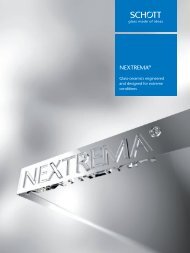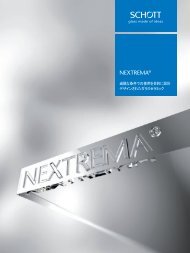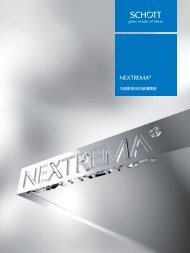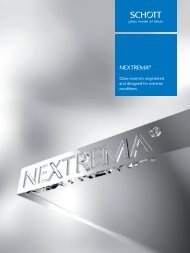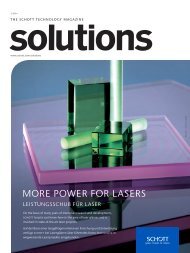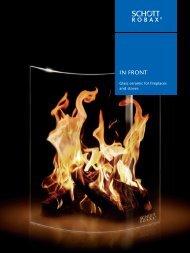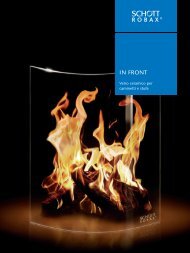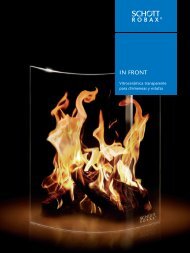SCHOTT Technical Glasses
Apart from its application in optics, glass as a technical material has exerted a formative influence on the development of important technological fields such as chemistry, pharmaceutics, automotive, optics, optoelectronics and information technology. SCHOTT Technical Glasses offers pertinent information in concise form. It contains general information for the determination and evaluation of important glass properties and also informs about specific chemical and physical characteristics and possible applications of the commercial technical glasses produced by SCHOTT. With this brochure, we hope to assist scientists, engineers, and designers in making the appropriate choice and make optimum use of SCHOTT products.
Apart from its application in optics, glass as a technical material has exerted a formative influence on the development of important technological fields such as chemistry, pharmaceutics, automotive, optics, optoelectronics and information technology. SCHOTT Technical Glasses offers pertinent information in concise form. It contains general information for the determination and evaluation of important glass properties and also informs about specific chemical and physical characteristics and possible applications of the commercial technical glasses produced by SCHOTT. With this brochure, we hope to assist scientists, engineers, and designers in making the appropriate choice and make optimum use of SCHOTT products.
You also want an ePaper? Increase the reach of your titles
YUMPU automatically turns print PDFs into web optimized ePapers that Google loves.
10<br />
2.2.1 Hydrolytic resistance (water resistance)<br />
Grain-titration method A<br />
(after leaching at 98 °C, according to DIN ISO 719; testing<br />
of glass as a material)<br />
An amount of 2 g of powdered glass with 300 – 500 µm<br />
(ISO) grain size is heated with 50 ml water for one hour in<br />
a boiling water bath. The extracted alkali is then titrated<br />
with hydrochloric acid, c(HCI) = 0.01 mol/l*, using methyl<br />
red sodium as an indicator. On the basis of the acid consumption<br />
(or its alkali equiva lent), the glass is assigned to one<br />
of the five hydrolytic class es listed in Table 1. The hydrolytic<br />
classes shown in Table 20 (on page 68ff) were determined<br />
using the above method.<br />
Grain-titration method B<br />
(after leaching at 121 °C, according to DIN ISO 720; testing<br />
of glass as a material)<br />
In this method, which originated in the USA and is particularly<br />
suitable for highly resistant glasses, 10 g of powdered<br />
glass (grain size 300 – 425 µm) is leached with 50 ml of water<br />
in an autoclave for 30 min at 121 °C. The extracted alkali is<br />
then titrated with hydrochloric acid, c(HCI) = 0.02 mol/l,<br />
using methyl red sodium as an indicator. Here, too, the acid<br />
consumption is a measure of the hydrolytic resistance. Presently,<br />
no allocation into classes exists for DIN ISO 720.<br />
Class 1<br />
Consumption of hydrochloric<br />
acid solution<br />
[c(HCl) = 0.02 mol/l] (4.2)<br />
per gram of glass grains<br />
ml/g<br />
Equivalent of alkali<br />
expressed as mass of<br />
sodium oxide (Na 2 O)<br />
per gram of glass grains<br />
µg/g<br />
HGA 1 up to and including 0.10 up to and including 62<br />
HGA 2<br />
HGA 3<br />
from 0.10 up to and<br />
including 0.85<br />
from 0.85 up to and<br />
including 1.50<br />
from 62 up to and<br />
including 527<br />
from 527 up to and<br />
including 930<br />
1<br />
“HGA” stands for the hydrolytic resistance of glass grains according<br />
to the autoclave test method.<br />
Table 2. Limit values in the hydrolytic resistance grain test (autoclave test)<br />
Surface test method A<br />
(at 121 °C, according to ISO 4802-1 (2010) and current<br />
Ph. Eur. and USP)<br />
Grain-titration methods are always carried out on crushed<br />
glass samples and the glass is tested as a material. With the<br />
surface test method, in contrast, the water resistance of<br />
the surface can be determined in its “as delivered” state. In<br />
this method, new, undamaged vessels (e.g. flasks, test tubes,<br />
vials, ampoules) are filled with water and heated for 60 min<br />
at 121 °C in an autoclave. The leaching solution is then<br />
titrated with hydrochloric acid, c(HCI) = 0.01 mol/l, using<br />
methyl red sodium as an indicator. Distinguished according<br />
to volume, the containers are classified on the basis of the<br />
amount of acid required for neutralization.<br />
The values gained by this method indicate not only the<br />
behavior of the glass material as such, but also reflect possible<br />
modifications induced in the glass surface during hot<br />
forming. Therefore, these values are not quoted in the tables<br />
included in this publication.<br />
DURAN ® borosilicate glass in the laboratory<br />
* The old term for concentration in “normal solutions N” has been replaced by “mol/l” in the SI system.






